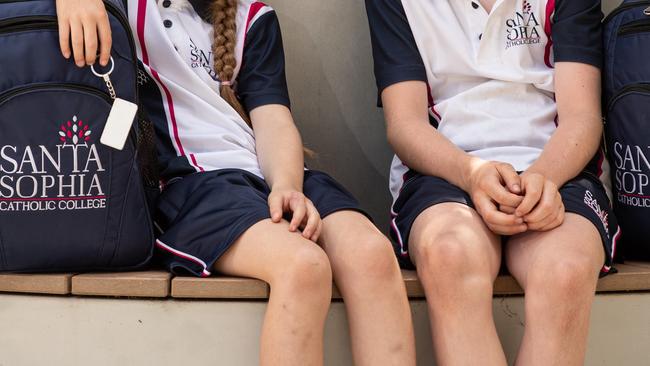Ratios revealed: How many teachers does your school have?
Stalled progress on student-to-teacher ratios have prompted a call for greater state school funding as new analysis reveals Catholic schools have fewer teachers than their public counterparts on average. SEARCH FOR YOUR SCHOOL.

Schools Hub
Don't miss out on the headlines from Schools Hub. Followed categories will be added to My News.
Editor’s Note:A previous version of this article incorrectly listed Rissalah College Lakemba as among the Top 3 worst schools for student-teacher ratios. Rissalah’s student to teacher ratio in its secondary school is 11.64, not 20.28.
Stalled progress on student-to-teacher ratios have prompted a call for greater state school funding despite new analysis revealing Catholic schools have fewer teachers than their public counterparts on average.
Figures from the Australian Curriculum, Assessment and Reporting Authority show Catholic schools in NSW have the highest ratios with an average of almost 15:1, compared to 14:1 across government schools and 12:1 for the independent sector.
Excluding ‘micro schools’ with fewer than 100 students, which are largely located in rural areas or cater to niche demographics, the schools with the best student to teacher ratios in NSW are government-run schools of distance education and ‘special’ schools – both state and independently operated – for students with special needs, such as Carenne School and Aspect branches.
Further down the list are high-fee private schools such as Frensham School in Mittagong and Masada College in St Ives with ratios of 7.7:1, significantly below the state median of 15.6 for medium-sized schools, and larger schools SCEGGS Darlinghurst and Queenwood with ratio of 8:1 and 8.5:1 respectively.
Masada College principal Raquel Chalet said the ratio of students to teachers is reflected in the school’s small class sizes and is a “conscious decision that reflects our commitment to educational excellence”.

“At Masada College, we believe that smaller class sizes foster a dynamic learning environment where students can thrive,” she said.
“With fewer students, teachers can implement strategies that encourage deep thinking, such as open-ended questioning, collaborative activities, and reflection on learning processes.”
Three in five of the fifty highest-ratio schools are Catholic schools, alongside 15 government schools scattered among booming greenfield suburbs like The Ponds, popular northern Sydney localities, and the suburbs of Newcastle.
At the top of the list is Santa Sophia Catholic College Primary, due to a quirk of ACARA’s reporting systems splitting teachers inaccurately between the school’s K-4 primary and 5-12 secondary campuses.

Five of the six independent schools with ratios of 19.5 or higher are Sydney Islamic schools, however despite their relatively few staff to a large student population, NAPLAN results show they are among the highest-achieving in the state.
The OECD describes evidence of the effects of reduced class size on student performance as “weak” and some overseas studies have even linked larger class sizes to improved outcomes.
Deputy director of the University of Newcastle’s Teachers and Teaching Research Centre Dr Andrew Miller said the ACARA data shows the more similar a school’s cohort is – whether by cultural background, socio-economic status or neurotypicality – the easier it is to achieve good results with fewer teachers.
A well-funded private school also has greater organisational capacity to facilitate bigger class sizes, he argued.
“The big problem with it is that, generally, the mix of students you have within a class is more diverse than the mix you have across classes, and smaller classes just make that variance easier to deal with,” Dr Miller said.

“We keep hearing that the money doesn’t matter, and that political argument is won when it comes to class sizes too. But ask any teacher if they’d love to reduce their class size, and I’d guarantee their answer is ‘yes’.”
NSW Teachers Federation President Henry Rajendra said the public school system urgently needs an additional $1.9 billion in funding from the federal government if there is to be any hope of improving ratios in state schools.

“Smaller class sizes allow teachers the time and capacity to attend to the needs of all students,” he said.
“It means they can devote extra time to a student who might have difficulty with a concept or one who wants to accelerate. When a teacher can help a student unlock a new concept it’s a magical moment. We need and deserve more of this classroom magic.
“Sadly for our students, there has been no substantial improvement to class sizes in years. The sooner we address this, the sooner we can give our kids the future they deserve.”



